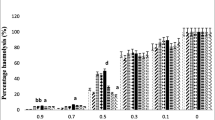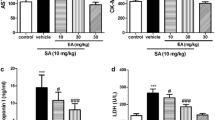Abstract
The aim of the present study was to evaluate the arsenic-induced hemotoxicity and to evaluate the protective effects of Lactobacillus sporogenes in male albino Wistar rats. A total of 36 adult male albino Wistar rats were procured and divided into 3 groups of 12 animals each. Group 1 rats served as control, group 2 rats were administered sodium arsenite (@5 mg/kg BW/day), groups 3 rats were supplemented with L. sporogenes (@15 million spores/kg BW/day) along with sodium arsenite administered along with sodium arsenite orally daily for 28 consecutive days. Weekly body weights, hematological profile, and erythrocyte morphology were assessed. Significant (P < 0.05) reduction in mean weekly body weights (g) was observed in group 2 than group 1; however, a significant (P < 0.05) increase in weekly body weights was observed in group 3 as compared to group 2. A significant (P < 0.05) decrease in erythrocyte-related parameters and platelet counts, and a significant (P < 0.05) leukocytosis, relative lymphopenia, absolute neutrophilia, and monocytosis were noticed among arsenic-treated rats when compared to the control group. Blood smear of arsenic-treated rats contains echinocytes, microcytes, and spherocytes when compared to control. Scanning electron microscopic examination of blood revealed altered erythrocyte morphology in arsenic-treated rats with poikilocytosis and blebbing of the erythrocyte membrane. Supplementation of L. sporogenes along with arsenic resulted in improvement of all the hematological parameters and reduction in morphological abnormalities in comparison to the toxic control group. It is concluded that supplementation of L. sporogenes can effectively alleviate the arsenic-induced hematological alterations.






Similar content being viewed by others
References
Ahmed KA, Korany RMS, El Halawany HA, Ahmed KS (2019) Spirulina platensis alleviates arsenic-induced toxicity in male rats: biochemical, histopathological and immunohistochemical studies. Adv Anim Vet Sci 7(8):701–710
Bhardwaj P, Dhawan DK (2019) Zinc treatment modulates hematological and morphological changes in rat erythrocytes following arsenic exposure. Toxicol Ind Health 35(9):593–603
Duan H, Yu L, Tian F, Fan L, Chen W (2020) Gut microbiota: a target for heavy metal toxicity and a probiotic protective strategy. Sci Total Environ 742: 140429
Ewere EG, Okolie NP, Etim OE, Oyebadejo SA (2020) Mitigation of arsenic-induced increases in pro-inflammatory cytokines and haematological derangements by ethanol leaf extract of Irvingia gabonensis. Asian J Res Biochem 7(1):36–47
FAO/WHO (2002) Guidelines for the evaluation of probiotics in food, report of a joint FAO/WHO working group on drafting guidelines for the evaluation of probiotics in food, London, Ontario, Canada 1–11.
Fendorf S, Michael HA, Geen AV (2010) Spatial and temporal variations of groundwater arsenic in South and Southeast Asia. Science 328(5982):1123–1127
Ghosh S, Mishra R, Biswas S, Bhadra RK, Mukhopadhyay PK (2017) α-Lipoic acid mitigates arsenic-induced hematological abnormalities in adult male rats. Iran J Med Sci 42(3):242–250
Giri SS, Yun S, Jun JW, Kim HJ, Kim SG, Kang JW, Kim SW, Han SJ, Sukumaran V, Park SC (2018) Therapeutic effect of intestinal autochthonous Lactobacillus reuteri P16 against waterborne lead toxicity in Cyprinus carpio. Front Immunol 9:1824
Iqbal MZ, Qadir MI, Hussain T, Janbaz KH, Khan YH (2014) Review: Probiotics and their beneficial effects against various diseases. Pak J Pharm Sci 27:405–415
Kolanjiappan K, Manoharan S, Kayalvizhi M (2002) Measurement of erythrocyte lipids, lipid peroxidation, antioxidants and osmotic fragility in cervical cancer patients. Clin Chim Acta 326:143–149
Lakshman M (2019) Application of conventional electron microscopy in aquatic animal disease diagnosis: a review. Journal of Entomology and Zoology Studies 7(1):470–475
Lu M, Wang H, Li XF, Arnold LL, Cohen SM, Le XC (2007) Binding of dimethylarsinous acid to cys-13r of rat hemoglobin is responsible for the retention of arsenic in rat blood. Chem Res Toxicol 20:27–37
Mahmud H, Foller M, Lang F (2009) Arsenic induced suicidal erythrocyte death. Arch Toxicol 83:107–113. https://doi.org/10.1007/s00204-008-0338-2
Mishra A, Niyogi PA (2011) Haematological changes in the Indian Murrel (Channa punctatus, Bloch) in response to phenolic industrial wastes of the Bhilai steel plant (Chhaittisgarh, India). Int J Res Chem Environ 1:83–91
Rad AH, Soroush AR, Khalili L, Panahi LN, Kasale Z, Ejtahed HS (2016) Diabetes management by probiotics: current knowledge and future prospective. Int J Vitam Nutr Res 86(3–4):215–227
Rana T, Sarkar S, Mandal T, Batabyal S (2007) Haematobiochemical profiles of affected cattle at arsenic prone zone in Haringhata block of Nadia District of West Bengal in India. Int J Hematol 4(2):1–4
Ranjit K, Pratibha K, Shalini AK, Ali M, Ashok G (2018) Hepatoprotective effect of Lactobacillus sporogenes against arsenic induced toxicity in mus musculus. World J Pharm Med Res 3(8):245–249
Shaji E , Santosh M, Sarath KV, Prakash P, Deepchand V, Divya B V (2021) Arsenic contamination of ground water: a global synopsis with focus on the Indian Peninsula. Geosci Front 12 (3): 101079.
Snedecor GW, Cochran G (1994) Statistical methods, 8th edn. IOWA State University Press, Amer, IOWA, USA
Sreeraman PK (2009) Veterinary Laboratory Diagnosis, 1st edn. Jaypee Brothers Medical Publishers (P) Ltd., New Delhi, India, pp: 105.
WHO (2001) Health and nutritional properties of probiotics in food including powder milk with live lactic acid bacteria. https://www.fao.org
World Health Organization (2006) A field guide: Detection, management and surveillance of arsenicosis. Technical Publication No. 30. New Delhi: WHO, SEARO, pp: 5–18
Funding
The authors are thankful to P V Narsimha Rao Telangana Veterinary University, Rajendranagar, Hyderabad, India, for funding the research.
Author information
Authors and Affiliations
Corresponding author
Ethics declarations
Conflict of Interest
The authors declare no competing interests.
Additional information
Publisher's Note
Springer Nature remains neutral with regard to jurisdictional claims in published maps and institutional affiliations.
Rights and permissions
About this article
Cite this article
Bora, S., Lakshman, M., Madhuri, D. et al. Protective Effect of Lactobacillus sporogenes against Arsenic-Induced Hematological Alterations in Male Albino Wistar Rats. Biol Trace Elem Res 200, 4744–4749 (2022). https://doi.org/10.1007/s12011-021-03055-9
Received:
Accepted:
Published:
Issue Date:
DOI: https://doi.org/10.1007/s12011-021-03055-9




